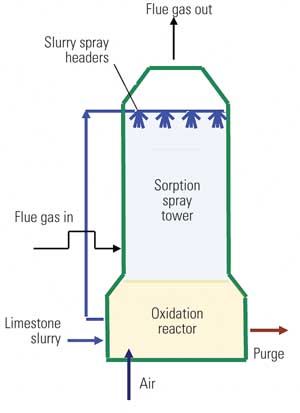Pollution Board to decide on future of FGD units: Minister

×
![]()
- This follows an April 2025 recommendation by a panel led by Principal Scientific Adviser Ajay Sood to do away with mandatory FGD installations.
- Currently, 92% of India’s 600 TPPs lack FGDs. If the recommendation is accepted, around 80% could be exempt from installing them.
- FGDs are used to reduce sulphur dioxide (SO₂) emissions, which contribute to air pollution and respiratory issues but also form sulphate aerosols that may slightly offset global warming.
- cited studies by CSIR and IIT Delhi, stating SO₂ emissions from Indian TPPs contribute less than 5% to human health impacts, suggesting some atmospheric sulphates may be beneficial in climate moderation.
- The government has extended deadlines for FGD compliance three times since 2017, most recently to 2027–2030.
Flue Gas and Flue Gas Desulphurisation (FGD)
(Relevant for UPSC Prelims and Mains – Environment, Pollution Control Technologies, Energy)
What is Flue Gas?
- Flue gas (exhaust or stack gas) is the by-product of fossil fuel combustion in industrial plants and power stations.
- It is expelled through chimneys or ducts (flues) and typically contains:
- Carbon dioxide (CO₂)
- Carbon monoxide (CO)
- Sulphur dioxide (SO₂)
- Nitrogen oxides (NO & NO₂)
- Water vapour, particulate matter, and trace pollutants
- The exact composition varies with fuel type and combustion conditions.
Importance of Flue Gas Analysis:
- Helps optimize air-to-fuel ratio for energy efficiency.
- Enhances burner efficiency, reducing fuel consumption.
- Essential for monitoring pollutant levels (SO₂, NOx) to comply with environmental standards.
- Prevents corrosion and protects equipment by tracking acid-forming emissions.
What is Flue Gas Desulphurisation (FGD)?
- FGD is a pollution control technology used to remove sulphur dioxide (SO₂) from flue gases.
- Primary goal: Reduce acid rain, improve air quality, and meet emission regulations.
- FGD can remove up to 90–95% of SO₂ emissions in coal-fired power plants.
FGD Process:
- Involves spraying uncleaned flue gas with an absorbent slurry (usually lime or limestone with water) in a scrubber tower.
- Chemical reaction bonds SO₂ with the slurry, removing up to 95% of the gas.
- Other absorbents like ammonia or sodium sulphite may also be used.
FGD Methods:
- Wet scrubbing:
- Uses limestone or lime slurry (or seawater) in scrubber towers to chemically react with and remove SO₂.
- Spray-dry scrubbing:
- Similar to wet scrubbing but uses atomised sorbent slurries sprayed into a hot flue gas stream.
- Dry sorbent injection:
- Involves injecting powdered hydrated lime or other sorbents into exhaust ducts to capture SO₂ and SO₃.
- Wet sulfuric acid process:
- Recovers sulphur as commercial-grade sulfuric acid.
- SNOX process:
- Simultaneously removes sulphur dioxide, nitrogen oxides, and particulates from flue gas without using absorbents.
FAQs:
- Q1: What is
flue gas?
→ Gas emitted from combustion of fossil fuels in power or industrial plants. - Q2: Why is
flue gas analysis important?
→ For improving combustion efficiency and meeting emission regulations. - Q3:
Why is it called 'flue' gas?
→ Because it exits through ‘flues’—industrial ducts or chimneys.
